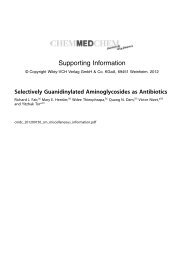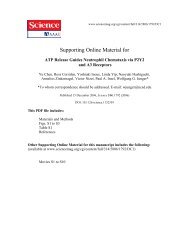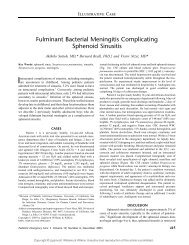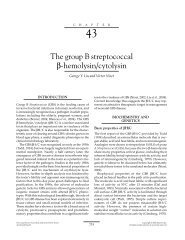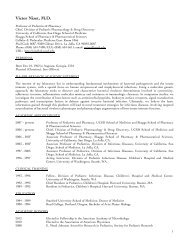BACTERIAL SEPSIS AND MENINGITIS - Nizet Laboratory at UCSD
BACTERIAL SEPSIS AND MENINGITIS - Nizet Laboratory at UCSD
BACTERIAL SEPSIS AND MENINGITIS - Nizet Laboratory at UCSD
You also want an ePaper? Increase the reach of your titles
YUMPU automatically turns print PDFs into web optimized ePapers that Google loves.
ampicillin. Many of these organisms are susceptible to<br />
penicillinase-resistant penicillins, such as nafcillin, and<br />
to first-gener<strong>at</strong>ion cephalosporins. Methicillin-resistant<br />
staphylococci th<strong>at</strong> are resistant to other penicillinaseresistant<br />
penicillins and cephalosporins have been<br />
encountered in many nurseries in the United St<strong>at</strong>es. Antimicrobial<br />
susceptibility p<strong>at</strong>terns must be monitored by<br />
surveillance of staphylococcal strains causing infection<br />
and disease in each NICU. Bacterial resistance must be<br />
considered whenever staphylococcal disease is suspected<br />
or confirmed in a p<strong>at</strong>ient, and empirical vancomycin therapy<br />
should be initi<strong>at</strong>ed until the susceptibility p<strong>at</strong>tern of<br />
the organism is known. Virtually all staphylococcal strains<br />
isol<strong>at</strong>ed from neon<strong>at</strong>es have been susceptible to vancomycin.<br />
Synergistic activity is provided by the combin<strong>at</strong>ion<br />
of an aminoglycoside (see Chapter 17). Vancomycinresistant<br />
and glycopeptide-resistant S. aureus has been<br />
reported from Japan and the United St<strong>at</strong>es, but none of<br />
these strains has been isol<strong>at</strong>ed from neon<strong>at</strong>es.<br />
CoNS can cause systemic infection in very low birth<br />
weight infants and in neon<strong>at</strong>es with or without devices<br />
such as an intravascular c<strong>at</strong>heter or a ventriculoperitoneal<br />
shunt. Vancomycin is the drug of choice for tre<strong>at</strong>ment of<br />
serious CoNS infections. If daily cultures from an indwelling<br />
device continue to grow CoNS, removal of the foreign<br />
m<strong>at</strong>erial probably is necessary to cure the infection.<br />
Enterococcus species are only moder<strong>at</strong>ely susceptible to<br />
penicillin and highly resistant to cephalosporins. Optimal<br />
antimicrobial therapy for neon<strong>at</strong>al infections caused<br />
by Enterococcus includes ampicillin or vancomycin in<br />
addition to an aminoglycoside, typically gentamicin or<br />
tobramycin.<br />
L. monocytogenes is susceptible to penicillin and ampicillin<br />
and resistant to cephalosporins. Ampicillin is the preferred<br />
agent for tre<strong>at</strong>ing L. monocytogenes, although an aminoglycoside<br />
can be continued in combin<strong>at</strong>ion with ampicillin<br />
if the p<strong>at</strong>ient has meningitis. Specific management of<br />
L. monocytogenes infection is discussed in Chapter 14.<br />
The choice of antibiotic therapy for infections caused<br />
by gram-neg<strong>at</strong>ive bacilli depends on the p<strong>at</strong>tern of susceptibility<br />
for these isol<strong>at</strong>es in the nursery th<strong>at</strong> cares for<br />
the neon<strong>at</strong>e. These p<strong>at</strong>terns vary by hospital or community<br />
and by time within the same institution or community.<br />
Although isol<strong>at</strong>es from neon<strong>at</strong>es should be<br />
monitored to determine the emergence of new strains<br />
with unique antimicrobial susceptibility p<strong>at</strong>terns, the general<br />
p<strong>at</strong>tern of antibiotic susceptibility in the hospital is a<br />
good guide to initial therapy for neon<strong>at</strong>es. Aminoglycosides,<br />
including gentamicin, tobramycin, netilmicin, and<br />
amikacin, are highly active in vitro against virtually all<br />
isol<strong>at</strong>es of E. coli, P. aeruginosa, Enterobacter species,<br />
Klebsiella species, and Proteus species.<br />
Role of Third-Gener<strong>at</strong>ion Cephalosporins<br />
and Carbapenems<br />
The third-gener<strong>at</strong>ion cephalosporins, cefotaxime, ceftriaxone,<br />
and ceftazidime, possess <strong>at</strong>tractive fe<strong>at</strong>ures for<br />
therapy for bacterial sepsis and meningitis in newborns,<br />
including excellent in vitro activity against GBS and E. coli<br />
and other gram-neg<strong>at</strong>ive enteric bacilli. Ceftazidime is<br />
highly active in vitro against P. aeruginosa. None of the<br />
CHAPTER 6 Bacterial Sepsis and Meningitis<br />
259<br />
cephalosporins is active against L. monocytogenes or Enterococcus,<br />
and activity against S. aureus is variable. The thirdgener<strong>at</strong>ion<br />
cephalosporins provide concentr<strong>at</strong>ions of drug<br />
<strong>at</strong> most sites of infection th<strong>at</strong> gre<strong>at</strong>ly exceed the minimum<br />
inhibitory concentr<strong>at</strong>ions of susceptible p<strong>at</strong>hogens, and<br />
there is no dose-rel<strong>at</strong>ed toxicity. Clinical and microbiologic<br />
results of studies of sepsis and meningitis in neon<strong>at</strong>es<br />
suggest th<strong>at</strong> the third-gener<strong>at</strong>ion cephalosporins<br />
are comparable to the traditional regimens of penicillin<br />
and an aminoglycoside (see Chapter 37) [620–623].<br />
Because ceftriaxone can displace bilirubin from serum<br />
albumin, it is not recommended for use in neon<strong>at</strong>es unless<br />
it is the only agent effective against the bacterial p<strong>at</strong>hogen.<br />
Meropenem is a broad-spectrum carbapenem antibiotic<br />
with extended-spectrum antimicrobial activity<br />
including P. aeruginosa and excellent CSF penetr<strong>at</strong>ion th<strong>at</strong><br />
appears safe and efficacious in the neon<strong>at</strong>e for tre<strong>at</strong>ment<br />
of most nosocomial gram-neg<strong>at</strong>ive p<strong>at</strong>hogens [624].<br />
The rapid development of resistance of gram-neg<strong>at</strong>ive<br />
enteric bacilli when cefotaxime is used extensively for<br />
presumptive therapy for neon<strong>at</strong>al sepsis suggests th<strong>at</strong><br />
extensive use of third-gener<strong>at</strong>ion or fourth-gener<strong>at</strong>ion<br />
cephalosporins can lead to rapid emergence of drugresistant<br />
bacteria in nurseries [625]. Also of concern, studies<br />
have identified a principal risk factor for development of<br />
invasive infection with Candida and other fungi in preterm<br />
neon<strong>at</strong>es to be extended therapy with third-gener<strong>at</strong>ion<br />
cephalosporins [626,627]. Empirical use of cefotaxime in<br />
neon<strong>at</strong>es should be restricted to infants with evidence of<br />
meningitis or with gram-neg<strong>at</strong>ive sepsis. Continued<br />
cefotaxime therapy should be limited to infants with gramneg<strong>at</strong>ive<br />
meningitis caused by susceptible organisms or<br />
infants with ampicillin-resistant enteric infections [628].<br />
CURRENT PRACTICE<br />
The combin<strong>at</strong>ion of ampicillin and an aminoglycoside,<br />
usually gentamicin or tobramycin, is suitable for initial<br />
tre<strong>at</strong>ment of presumed early-onset neon<strong>at</strong>al sepsis [629].<br />
If there is a concern for endemic or epidemic staphylococcal<br />
infection, typically occurring beyond 6 days of<br />
age, the initial tre<strong>at</strong>ment of l<strong>at</strong>e-onset neon<strong>at</strong>al sepsis<br />
should include vancomycin.<br />
The increasing use of antibiotics, particularly in<br />
NICUs, can result in alter<strong>at</strong>ions in antimicrobial susceptibility<br />
p<strong>at</strong>terns of bacteria and can necessit<strong>at</strong>e changes<br />
in initial empirical therapy. This alter<strong>at</strong>ion of the microbial<br />
flora in nurseries where the use of broad-spectrum<br />
antimicrobial agents is routine supports recommend<strong>at</strong>ions<br />
from the CDC for the judicious use of antibiotics.<br />
The hospital labor<strong>at</strong>ory must regularly monitor isol<strong>at</strong>es<br />
of p<strong>at</strong>hogenic bacteria to assist the physician in choosing<br />
the most appropri<strong>at</strong>e therapy. The clinical pharmacology<br />
and dosage schedules of the various antimicrobial agents<br />
considered for neon<strong>at</strong>al sepsis are provided in Chapter 37.<br />
CONTINUATION OF THERAPY WHEN RESULTS<br />
OF CULTURES ARE AVAILABLE<br />
The choice of antimicrobial therapy should be reevalu<strong>at</strong>ed<br />
when results of cultures and susceptibility tests<br />
become available. The dur<strong>at</strong>ion of therapy depends on



